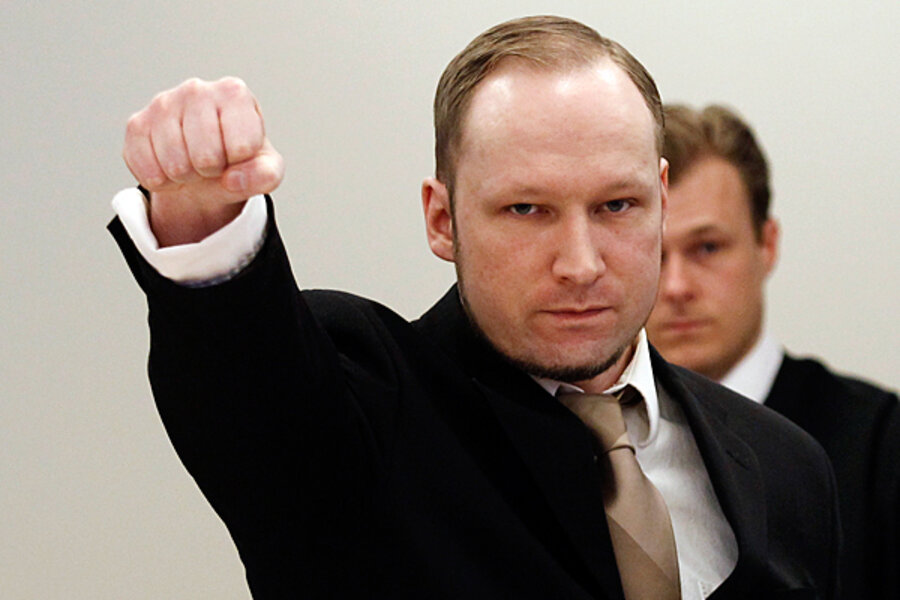Anders Breivik says he killed to protect indigenous Norwegians
Loading...
| Oslo
The second day of the historic trial against Norwegian mass murderer Anders Behring Breivik began with an ideologically charged testimony in defense of last summer’s twin terror attacks and the surprise removal of one of the nonprofessional judges.
Breivik defended killing 77 people last July as a preventive attempt to protect indigenous Norwegians from the civil war that would ensue from multiculturalists’ promotion of Muslim immigration to Europe.
In his hour-long opening speech, Breivik compared his actions to the World War II commanders’ bombing of Hiroshima and Nagasaki to save millions of lives and Sitting Bull’s fight for Native Americans.
“Were they [Sitting Bull, Crazy Horse] terrorists for fighting for their indigenous culture … or were they heroes?” he said. “My acts are based on goodness, not evil,” he added. “If anyone is vicious it is the Socialists.”
Breivik was allowed to continue reading aloud his 13-page prepared text, despite exceeding his 30-minute limit and amid protests from the legal counsel for the victims, whose clients were offended.
After resuming, Brevik went on to call the Labor party parliamentarians and pro-multicultural political elite insane, contending that “it is irrational to deconstruct one’s own group,” and insisting he had acted on the “principle of necessity.”
“If what I am saying is true, how can what I have done been illegal?” he said. “How can it be illegal to show armed resistance to these groups?”
Breivik is charged for terrorist attacks and pre-meditated murder after planting a car bomb outside the government’s main office buildings in Oslo and going on a shooting spree at the ruling Labor party’s summer youth camp on the nearby island of Utøya.
His testimony over the next five days is expected to be central in this historic trial, which is now focused on Breivik’s sanity after two conflicting forensic reports.
The first report in November concluded the 33-year old was paranoid schizophrenic, and hence criminally not punishable for his actions. The second set of psychiatrists announced last week they found Brevik sane, which makes prison time possible for Norway’s most notorious killer in modern times.
The prosecutors’ indictment – issued in March, when only the report finding Breivik insane was out – recommends he be transferred to compulsory mental care for having committed the acts in a psychotic state. However, it allows for changing to a 21 years’ sentence of imprisonment or preventive detention during the course of the trial if they feel the evidence instead shows him to be sane.
Geir Lippestad, Breivik’s defense attorney, said yesterday in a press conference that his client’s testimony over the next days would be the most important piece of evidence presented to the court in determining his client’s sanity. Mr. Lippestad said last week that his client felt it was important to be considered sane so that his ideology would "stand stronger."
The trial began today with Breivik flashing a clenched-fist salute. Shortly thereafter, Judge Wenche Elizabeth Arntzen recommending that Thomas Indrebø, one of the three lay judges in this case, withdraw immediately from the case for having posted on Facebook, “The death penalty is the only just thing to do in this case!” on the day after the attack. In Norwegian courts, two professional judges and three lay judges – in this case ordinary Oslo residents – determine a judgement in the case.
The replacement marks the second in this high-profile case after one of the original three lay judges was forced to step down prior to the trial because of his ties to the Labor party, the target of Breivik’s attacks. The situation poses no technical problem for the case as there are two reserve lay judges. However it highlights the problem of ensuring an unbiased judgement in a small country of five million where most people know someone who was affected by the attack.
Breivik began his trial yesterday by denouncing the legitimacy of the court and pleading not guilty. He remained stoic during most of the prosecutors' hours-long opening statement, even during the reading of graphic descriptions of death from the indictment and an emergency phone call from a terrified teenager hiding in a bathroom on Utøya with repeated rounds of gunfire in the background.
His only moment of emotion was when he was moved to tears during the viewing of his 12-minute propaganda movie trailer Knights Templar 2083, which he released online shortly before his shooting spree.
“It was a very touching film,” Breivik said today during cross-examination by Inga Bejer Engh, Oslo public prosecutor, when asked about his unexpected reaction in court. “I thought, 'My country and my ethnic group are dying.' ”
Engh focused her cross-examination today on establishing who gave Breivik the authority to carry out his attacks. He argued that his killing spree was justified based on the “universal human right” of defending indigenous people against ethnic cleansing, but underlined that no sovereign state or organization had given him the authority.
“I see this as an unliveable injustice,” said Breivik, referring to the attacks. “But it was my own choice.”








